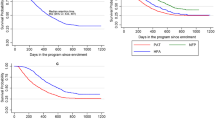Abstract
This study compared the effects of a community-based lay home visiting initiative for pregnant adolescents, the Norfolk Resource Mothers Program, with the effects of a more traditional clinic-based program. The Resource Mothers Program (RMP) supports disadvantaged teens through the use of para-professional home visitors who are similar to the teens in race and socio-economic status. In addition to recruiting teens into the program and encouraging early prenatal care, the Resource Mothers Program provides teen mothers and their families with practical help and increases community awareness regarding infant mortality and adolescent pregnancy. When compared with a traditional clinic-based multi-disciplinary program (MDP) using health professionals, the Resource Mothers Program reached a higher percentage of high-risk adolescents (e.g., 75.5% RMP vs. 45.6% MDP clients aged 17 years old or under), promoted a higher level of prenatal care (e.g., 53.1% RMP vs. 32.6% MDP clients beginning prenatal care before the fourth month of pregnancy), and resulted in pregnancy outcomes that favored the MDP but were comparable (e.g., 89.8% RMP vs. 93.5% MDP client babies were over 2500 grams at birth).
Similar content being viewed by others
References
National Center for Health Statistics:Health, United States, 1991. Hyattsville, MD: Public Health Service: 149, 1992.
National Center for Health Statistics:Health, United States, 1990. Hyattsville, MD: Public Health Service: 68, 1991.
Young, CL, McMahon, J, Bowman, VM, and Thompson, D: Adolescent third-trimester enrollment in prenatal care.J Adoles Health Care 10: 393–397, 1989.
Zambrana, RE, Dunkel-Schetter, C, and Scrimshaw, S: Factors which influence use of prenatal care in low-income recial-ethnic women in Los Angeles county.J Comm Health 16: 283–295, 1991.
Thompson, RJ, Cappleman, MW, Zeitschel, KA: Neonatal behavior of infants of adolescent mothers.Dev Med Child Neurol 21: 474–485, 1979.
General Accounting Office.Home Visiting — A Promising Early Intervention Strategy for at-Risk Families. Washington, DC: Government Printing Office: 59–61, 1990.
Grantham-McGregor, S, Schofield, W, and Powell, C: Development of severely malnourished children who received psychosocial stimulation: Six year follow-up.Ped 79: 376–391, 1987.
Seitz, V, Rosenbaum, LK, Apfel, NH: Effects of family support intervention: A ten-year follow-up.Child Dev 56: 247–254, 1985.
Buescher, PA, Meis, PJ, Ernst, JM, Moore, ML, Michielutte, R, Sharp, P: A comparison of women in and out of a prematurity prevention project in a North Carolina perinatal care region.Am J Public Health 78: 264–267, 1985.
Heins, HC Jr, Nance, NW, Ferguson, JE: Social support in improving perinatal outcomes: the Resource Mothers Program.Obstet Gynecol 70: 263–266, 1987.
Musick, JS, Bernstein, V, Percansky, C, Stott, FM: A chain of enablement: using community-based programs to strengthen relationships between teen parents and their infants.Zero to Three 8: 1–6, 1987.
Poland, ML, Giblin, PT, Waller, JB, and Hankin J Effects of a home visiting program on prenatal care and birthweight: A case comparison study.J Comm Health 17: 221–229, 1992.
Center of Health Statistics:Virginia Vital Statistics, 1990 Annual Report. Richmond, VA: Virginia Department of Health: 16–18, 1991.
Binsacca, DB, Ellis, J, Martin, DG, and Petitti, DB: Factors associated with low-weight in an inner city population: The role of financial problems.Am J Pub Health 77: 505–506, 1987.
Kinsman, SB, and Slap, GB: Barriers to adolescent prenatal care.J Adoles Health 13: 146–154, 1992.
Poland, ML, Ager, JW, Olson, JM: Barriers to receiving adequate prenatal care.Am J Obstet Gynecol 157: 297–303, 1987.
Giblin, PT, Poland, ML, and Ager, JW: Effects of social support on attitudes, health behaviors and obtaining prenatal care.J Comm Health 15: 357–368, 1990.
Author information
Authors and Affiliations
Rights and permissions
About this article
Cite this article
Julnes, G., Konefal, M., Pindur, W. et al. Community-based perinatal care for disadvantaged adolescents: Evaluation of the resource mothers program. J Community Health 19, 41–53 (1994). https://doi.org/10.1007/BF02260520
Issue Date:
DOI: https://doi.org/10.1007/BF02260520




